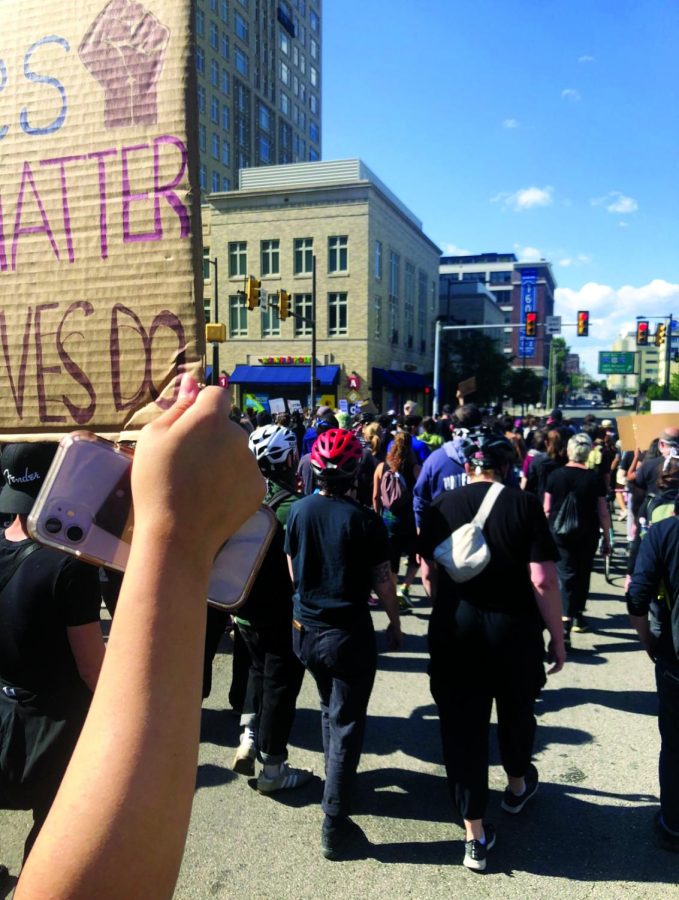Volunteers advise how to help, not hurt
Sharing the red and green flags to look for while researching potential organizations to donate to, experienced volunteers offer advice on how to find the most credible places to donate your time and money.
Supporting a cause…marching through Philadelphia, citizens held a protest to show their support for the Black Lives Matter (BLM) movement. There have been many donations held by the BLM organization and many individuals where people can demonstrate their support for the cause.
May 26, 2022
To help the Souderton community find trustworthy organizations to donate to, those who regularly donate and volunteer share advice on finding the most fitting organization and speak on past experiences.
Souderton alumni Colin Slade advises students to stay local when donating. “I think it’s best to stay local,” Slade said. “It’s easiest to familiarize yourself with the material conditions of the people that live in your own community.”
Over the summer of 2020, Slade went to multiple Black Lives Matter protests and helped by donating supplies to organizers and protesters.
According to Slade, they donated water and baking soda for protesters who were being teargassed so they could make a solution to help diminish the pain.
“I think it’s good that people have the inclination to make a donation or to make a gesture of support,” Slade said.
Similarly, Art for Social Change Co-President (AFSC) Miranda Razzi feels that donating to local organizations has many benefits.
One of the local organizations that AFSC donates to is the Laurel House, an organization whose purpose is to help women and children who have been in domestic abuse situations.
“We’ve built a really great relationship with them. They know us and [AFSC advisor Ginny] Perry,” Razzi said. “There’s a lot of people in the community who work with them, so we really see that our donation is making a difference first hand.”
According to Perry, the club sold paintings at Souderton Area High School’s Art and Soul fest and donated the profits to the Laurel House.
“[We chose the Laurel House] because it’s local, and we felt in the club that it is an important cause,” Perry said.
Junior Caden Schaeffer regularly volunteers his time to a local pet shelter, Pawsibilities Animal Rescue.
Before volunteering, Schaeffer made sure the shelter was a good option to volunteer.
“I made sure they’re a no-kill shelter, which they are, and that they’ve had experience and are well-known enough that it adds a layer of trust,” Schaeffer said.
Along with making sure the shelter was a good fit, Schaeffer advises those looking to volunteer to focus on a topic or issue they’re interested in.
While staying local is a bonus to many, there are some red flags to look out for when finding organizations to donate to.
“When organizations aren’t being very transparent about exactly how their funds are broken down or examples of where the donation might go to, we would probably stay away from that,” Razzi said. “We try to focus on the [organizations] that are showing us where the money is going.”
According to Slade, many people who are truly in need of donations will know an exact amount they need, and will specify where the money is going, while organizations that are not in need may not specify where their donations will go and how they will be broken down.
“I think a lot of organizations will be nonspecific just so they can take advantage of a situation,” Slade said.
Another club at the high school that has held donations for the community is Cultural Awareness Alliance (CAA).
According to CAA co-leader Adryanna Bauman, the club held a sock drive to donate to people in the community.
“People will think about donating clothes, but socks are a thing that not a lot of people think about,” Bauman said. “We just look at who in our area is in need and what we can do for them.”
According to Bauman, it is “very important” to have compassionate people in the community, and that is the first step of action in helping others.

